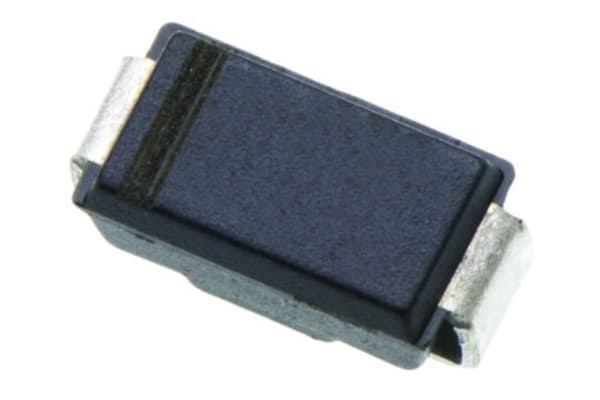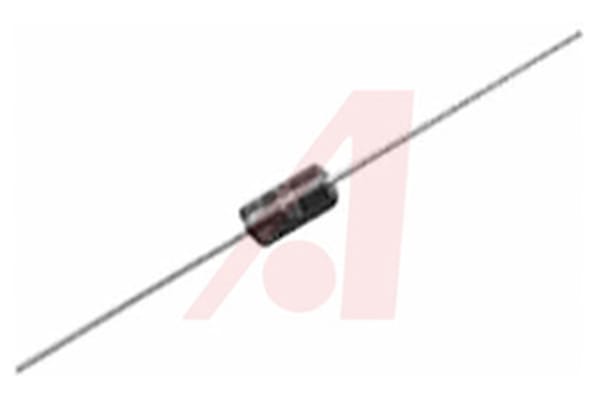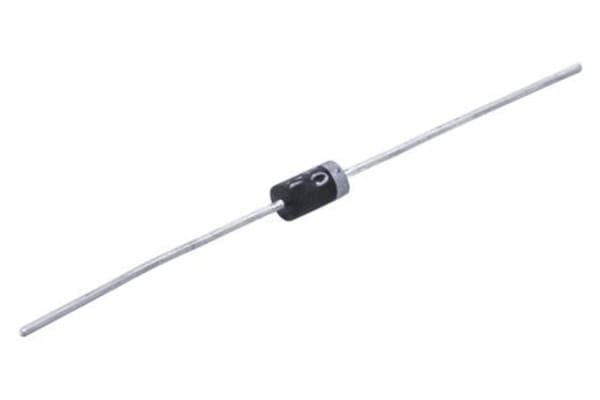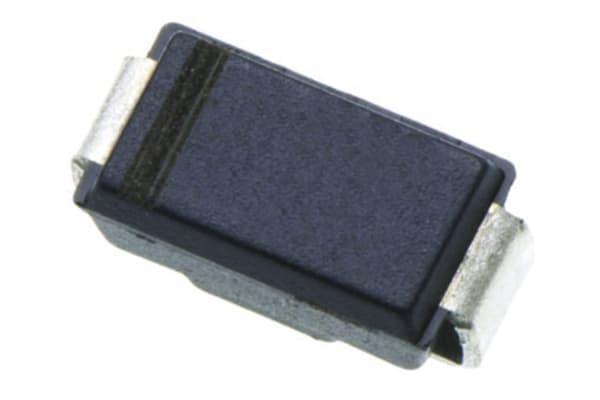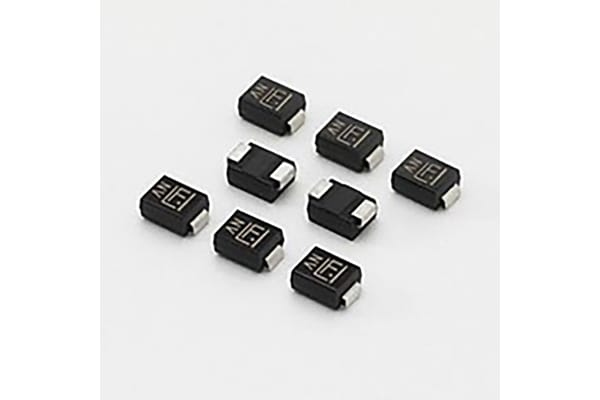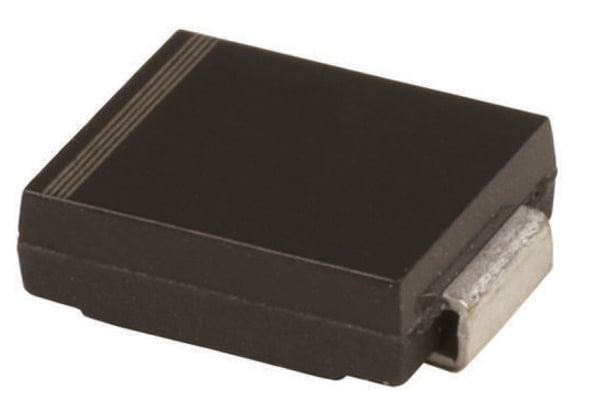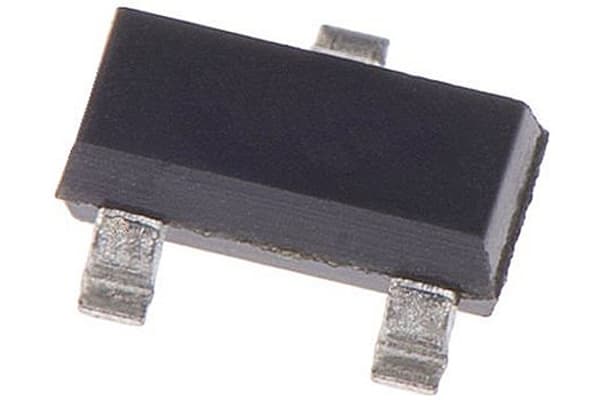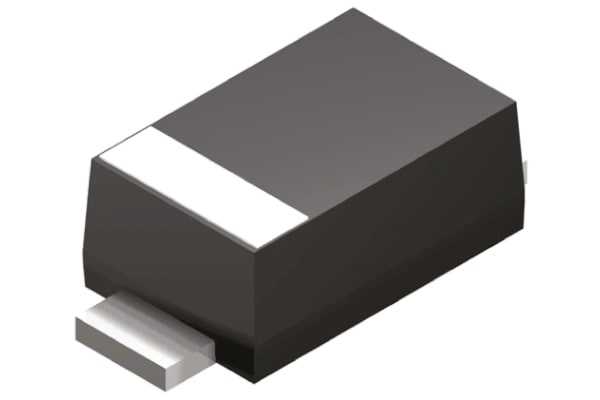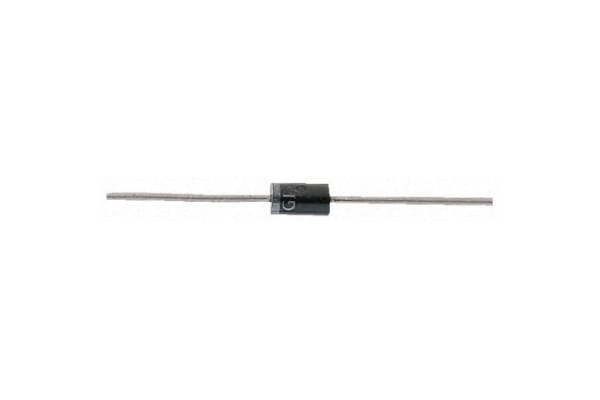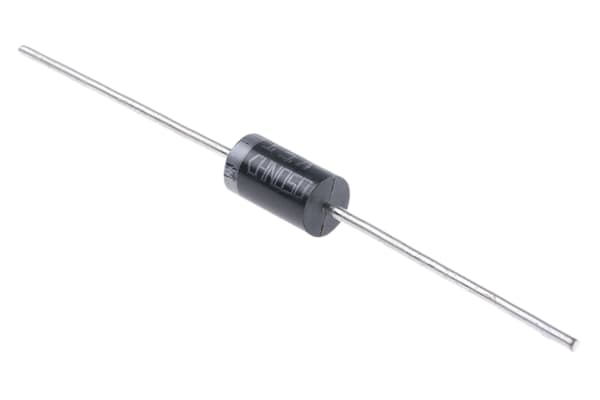TVS Diodes
Transient voltage suppressor diodes, more commonly known as TVS diodes, are used to protect integrated circuits (ICs). TVS diodes protect semiconductors and sensitive components against high transient voltage spikes (overvoltage) and the effects of arcs, EFT, ESD, inductive load switching, and even lightning strikes. RS Components offer an extensive range of TVS diodes from a multitude of brands across the industry, including Bourns, Littelfuse, ON Semiconductor, STMicroelectronics, Taiwan Semiconductor, Vishay, and more.TVS diodes are offered in both through-hole and surface mount packages and can be unidirectional or bidirectional. Unidirectional TVS diodes will only allow positive or negative voltage, whereas bidirectional diodes can operate at both positive and negative voltages. TVS diodes are able to conduct large currents to the ground due to their construction. They feature a much larger p-n junction cross-sectional area than standard diodes. You can learn more in our TVS diodes guide.What are the benefits of using transient voltage suppressor diodes?Transient voltage suppressors respond incredibly quickly to overvoltage events, clamping transient voltages almost immediately. This enables them to protect circuits from the effects of arcing, inductive load switching, EFT (electrical fast transients), the ESD (electrostatic discharge) created by data lines and electronic circuits, and even lightning strikes.What to consider when choosing a TVS diode?There are a number of differentiators when choosing a TVS diode, but two key factors to consider are reverse standoff voltage and breakdown voltage. Reverse standoff voltage is the operating voltage that the data or power line should not exceed. Breakdown voltage is the voltage rating at which the TVS diode will provide protection and start conducting current to the ground. This voltage value is normally a little higher than the reverse standoff voltage.Typical applications of TVS diodesTVS diodes have numerous applications but are primarily used to protect microprocessorsMOS memoryAC power linesTelecommunication equipmentConsumer electronics
-
Bourns CDSOD323-T05C, Bi-Directional TVS Diode, 350W, 2-Pin SOD-323
VND392,724.71Pack (1 Pack of 25) -
Bourns CDSOT23-SM712, Dual-Element Bi-Directional TVS Diode, 400W, 3-Pin SOT-23
VND294,595.84Pack (1 Pack of 10) -
Bourns SMAJ30CA, Bi-Directional TVS Diode, 400W, 2-Pin DO-214AC
VND375,777.08Pack (1 Pack of 50) -
Infineon ESD5V3U2U03FH6327XTSA1, Dual-Element Uni-Directional ESD Protection Diode, 3-Pin TSFP
VND544,416.46Pack (1 Pack of 50) -
Littelfuse 1.5KE6.8A, Uni-Directional TVS Diode, 1500W, 2-Pin DO-201
VND229,734.54Reel (1 Reel of 20) -
Littelfuse 1.5KE7.5CA, Bi-Directional TVS Diode, 1500W, 2-Pin DO-201
VND782,101.74Pack (1 Pack of 50) -
Littelfuse P6KE6.8A, Uni-Directional TVS Diode, 600W, 2-Pin DO-204AC
VND125,956.46Reel (1 Reel of 20) -
Littelfuse SMAJ28CA, Bi-Directional TVS Diode, 400W, 2-Pin DO-214AC
VND179,100.88Pack (1 Pack of 25) -
Littelfuse SMBJ18CA, Bi-Directional TVS Diode, 600W, 2-Pin DO-214AA
VND81,808.93Pack (1 Pack of 10) -
Littelfuse SMBJ60A, Uni-Directional TVS Diode, 600W, 2-Pin DO-214AA
VND117,378.03Pack (1 Pack of 20) -
Littelfuse SMCJ48CA, Bi-Directional TVS Diode, 1500W, 2-Pin DO-214AB
VND115,494.96Pack (1 Pack of 10) -
Nexperia PESD15VL2BT,215, Dual-Element Bi-Directional ESD Protection Diode, 200W, 3-Pin SOT-23
VND126,793.38Pack (1 Pack of 20) -
Nexperia PESD1FLEX,215, Dual-Element Bi-Directional TVS Diode, 200W, 3-Pin SOT-23
VND113,193.43Pack (1 Pack of 20) -
Nexperia PESD5V0U2BT,215, Dual-Element Bi-Directional TVS Diode, 3-Pin SOT-23
VND103,359.62Pack (1 Pack of 20) -
Nexperia PTVS3V3S1UR,115, Uni-Directional TVS Diode, 400W, 2-Pin SOD-123W
VND172,823.98Pack (1 Pack of 25) -
onsemi P6KE100CA, Bi-Directional TVS Diode, 600W, 2-Pin DO-15
VND59,839.78Pack (1 Pack of 5) -
onsemi P6KE15CA, Bi-Directional TVS Diode, 600W, 2-Pin DO-15
VND31,802.96Pack (1 Pack of 5) -
onsemi P6KE36CA, Bi-Directional TVS Diode, 600W, 2-Pin DO-15
VND64,024.38Pack (1 Pack of 5) -
onsemi SM12T1G, Dual-Element Uni-Directional TVS Diode, 300W, 3-Pin SOT-23
VND235,174.52Tape (1 Tape of 50) -
onsemi SMCJ33A, Uni-Directional TVS Diode, 1500W, 2-Pin DO-214AB
VND235,802.21Pack (1 Pack of 20) -
Semtech SM712.TCT, Dual-Element Bi-Directional TVS Diode, 400W, 3-Pin SOT-23
VND230,780.69Reel (1 Reel of 5) -
STMicroelectronics 1.5KE15A, Uni-Directional TVS Diode, 1500W, 2-Pin DO-201
VND152,947.13Pack (1 Pack of 10) -
STMicroelectronics 1.5KE18A, Uni-Directional TVS Diode, 1500W, 2-Pin DO-201
VND95,618.11Pack (1 Pack of 10) -
STMicroelectronics 1.5KE18CA, Bi-Directional TVS Diode, 1500W, 2-Pin DO-201
VND61,513.62Pack (1 Pack of 5)





